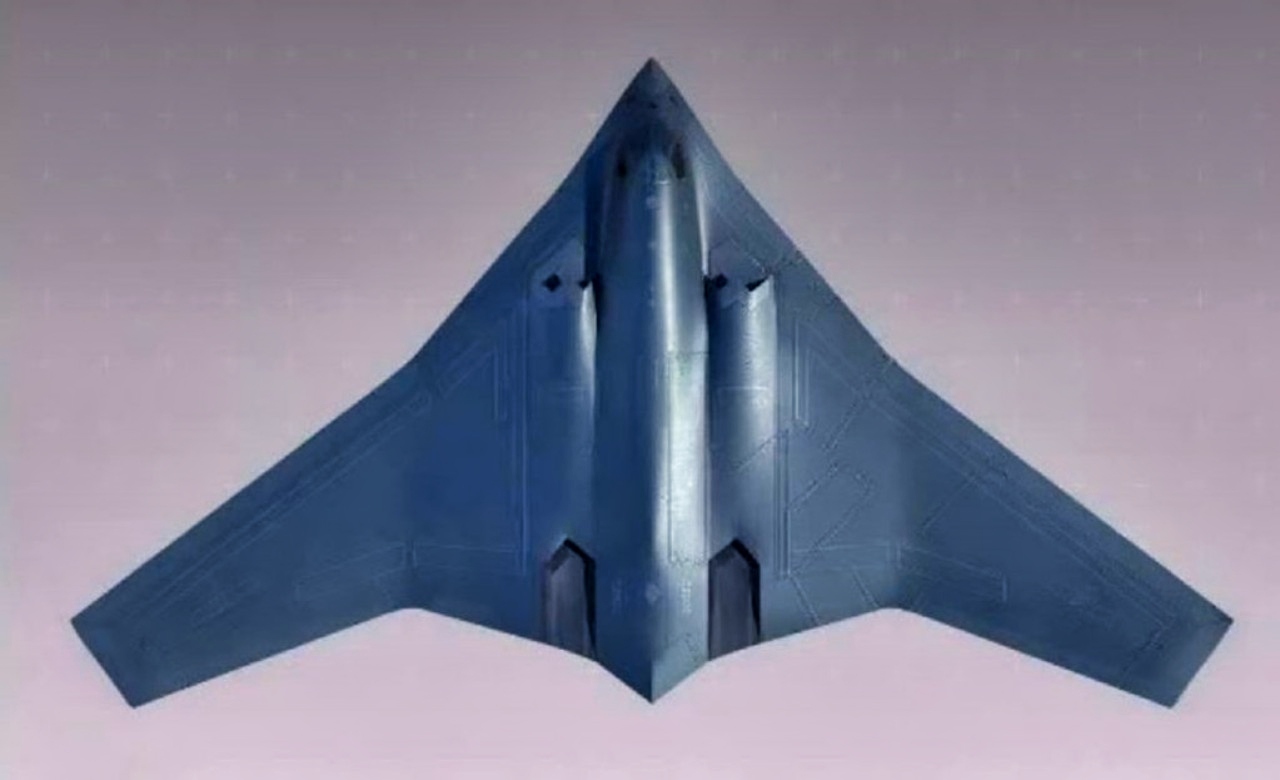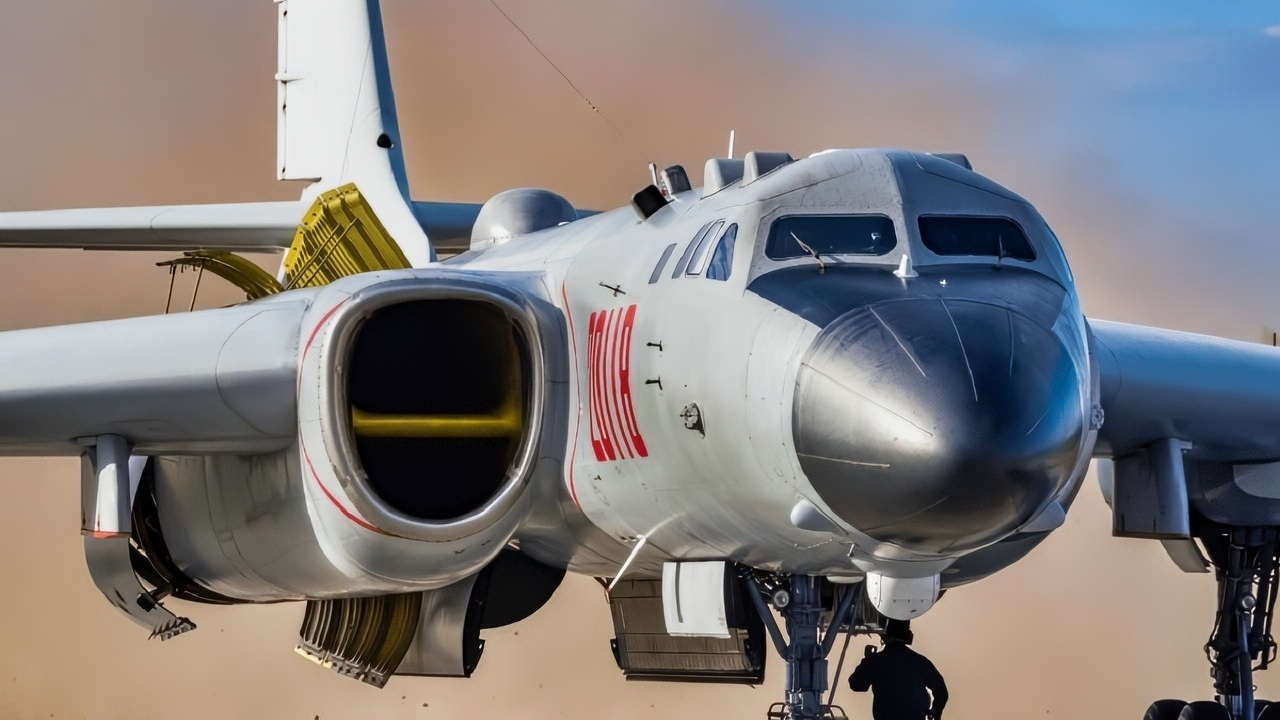Article Summary – H-6 Bomber: How China Turned a 1950s “Badger” Into a Modern Missile Truck
-China’s H-6 bomber began as a licensed Soviet Tu-16 in the late 1950s and has been refashioned into multiple, far more capable variants.

PLAAF Xian H-6M makes a turn over central Changzhou.
-What started as a gravity-bomb and nuclear delivery platform now flies as a standoff “missile truck” with modern sensors, turbofan engines, cruise missiles, and—in some versions—air-launched ballistic weapons and aerial refueling.
-The H-6 has moved from homeland defense to regular long-range patrols, maritime strike, and joint ops with Russia.
-Its future is as a bridge: a mass launcher that supports drones and, eventually, a stealth H-20, ensuring China’s bomber force remains relevant while next-generation designs mature.
H-6: The Bomber China Refused to Let Grow Old
I will never forget when my Editor at The Diplomat, where I worked at the time as an editor, back in 2011, asked me to commission a piece on the ‘old’ H-6 bomber, which China had flown and massively updated. I thought to myself, “Why does China keep updating this thing?” As I delved into the details back then, I quickly understood the reason.
I instantly wanted to call it China’s version of the B-52. But that doesn’t exactly fit the bill.
If you only saw the silhouette, you’d swear the H-6 was a Cold War fossil: straight-edged wings, twin pods slung under the roots, a slab-sided fuselage. But the story isn’t about the shape; it’s about everything China has stuffed inside and hung beneath that shape over six decades.
Beijing took a 1950s Soviet bomber—the Tu-16 “Badger”—and kept rewriting it for new missions, new sensors, and new weapons. The result is a family of aircraft that looks familiar at a distance and very modern up close.
China released footage of Chinese H-6 and Russian Tu-95 Bear strategic bomber joint “Freedom of Navigation Patrol” in international airspace near Alaska.
H-6 and Tu-95 Bear are designed to deliver nuclear weapons pic.twitter.com/w2H4MkMqUk
— Carl Zha (@CarlZha) July 26, 2024
The Russian Origin Story That Set the Template
When the People’s Republic of China sought a long-range bomber in the late 1950s, the Soviet Union’s Tu-16 was the apparent source. Licensing, technology transfer, and then domestic production created the first H-6s.
They were classic Cold War machines: large bomb bays for nuclear or conventional gravity bombs, analog cockpits, and turbojets that drank fuel and announced themselves with smoke. The Sino-Soviet split complicated support, but the basic airframe—robust, roomy, and easy to work on—gave Chinese industry the canvas it needed. Over time, Xian Aircraft Company learned to build and then re-engineer the bomber, gradually decoupling it from its Soviet DNA.
From Bombs to Missiles: The First Big Evolution
The early Chinese H-6s performed the same function as their Russian predecessors: delivering bombs. However, as air defenses grew increasingly lethal, the mission shifted from over-target bombing to standoff attacks. China adapted the design to carry anti-ship and land-attack cruise missiles externally, then updated the nose and avionics to support real look-down/shoot-down engagements.
Those changes were less glamorous than new airframes, but they mattered more: they moved the bomber’s role from “truck that drops” to networked shooter in a larger kill chain.
The H-6K: How a “Badger” Became a Modern Striker
The watershed was the H-6K. Two major shifts define it. First, the heart: efficient high-bypass turbofan engines replaced the older, smoky turbojets, buying range, fuel economy, and reliability. Second, the brain: a new nose eliminated the traditional glazed navigator’s station and made room for a modern radar; a glass cockpit and updated electronic support measures brought the crew into the 21st century.
The K added multiple under-wing pylons for long-range cruise missiles—think CJ-10-class land-attack weapons and heavy anti-ship missiles—so a formation of H-6Ks can launch a volley from outside dense air defenses. The tail guns vanished; electronic warfare and decoys took their place.
Same silhouette, new era.
The H-6J: The Navy’s “Carrier Killer” Hauler
The H-6J pushed those ideas to sea. Optimized for maritime strike with corrosion protection, new avionics, and naval comms, it typically carries a quiver of long-reach anti-ship cruise missiles (notably the YJ-12 family).
In a Western Pacific scenario, J-models would operate with maritime patrol aircraft, surface sensors, and targeting drones to launch salvos from well outside shipboard air-defense envelopes. In other words, the bomber is no longer the spear tip; it is the missile magazine, fired by a web of off-board eyes.
The H-6N: Refueling, Big Payloads, and Ballistic Surprises
Then came the H-6N, with a visible inflight-refueling probe and a redesigned belly that can carry a very large centerline weapon. Imagery and official media clips over the last few years have shown N- and K-model aircraft launching or lugging outsized munitions sometimes described as air-launched ballistic missiles—the kind of weapons that, in theory, can threaten distant air or maritime targets with little warning. Whether every H-6N sortie carries such a missile is beside the point.
Great image of a PLAAF H-6KG serial number 20013 from the 10th Bomber Division together with a F-16C, a F-35A and a F/A-18.
(Image via @Oneninety from Weibo) pic.twitter.com/7yx5DsLAcz
— @Rupprecht_A (@RupprechtDeino) July 25, 2024
The capability forces planners to respect the possibility, complicating how U.S. and allied forces flow into theater and defend key bases.
Where and How It Flies Today
What’s striking about the H-6 in 2025 isn’t the airframe—it’s the routine. Chinese bomber crews now train over water regularly, crossing the First Island Chain and pushing into the Philippine Sea. In 2018, an H-6K filmed landing on Woody Island in the Paracels signaled that South China Sea outposts can support bomber operations.
Joint patrols with Russian Tu-95s over the Sea of Japan and East China Sea have become periodic events, and in 2024, U.S. and Canadian fighters intercepted Chinese H-6s and Russian bombers operating inside Alaska’s Air Defense Identification Zone. The message is simple: long-range bomber presence is no longer an American monopoly.

Tu-95 Bomber Russian Air Force. Image Credit: Creative Commons.
H-6: The Missions That Make Sense
The H-6’s sweet spot is standoff attack at scale. Against land targets, bombers launch land-attack cruise missiles from beyond the reach of most ground-based defenses, forcing the defender to spend expensive interceptors and attention on a wave of inbound threats.
At sea, J- and K-models can contribute to maritime strike by hauling supersonic anti-ship missiles and firing them from outside an escort’s envelope.
And there’s the signaling mission—long-endurance patrols that show up over chokepoints, around Taiwan, or alongside Russian aircraft to send geopolitical messages without crossing borders.
The Variants—More Family Than Alphabet Soup
China has fielded multiple H-6 sub-families with overlapping roles. Earlier missile-carrying H-6s (often labeled H-6H or H-6M) pioneered external cruise-missile carriage. The H-6K brought the propulsion and sensor step change and mass external pylons for cruise missiles.
The H-6J ported the K’s logic to a navalized maritime-strike role. The H-6N added refueling and that cavernous centerline station (and, with it, the option to carry very large weapons or special payloads). Some airframes have acted as motherships for high-speed reconnaissance drones, suggesting a future in which the bomber is both shooter and scout director. Each letter reflects the same philosophy: keep the truck, keep upgrading the cargo and the cockpit.
How Beijing Turned a Legacy Bomber Into a Modern Threat
Three choices explain the H-6’s longevity.
Standoff over penetration. Rather than chase a B-2 analogue in the 1990s, China used the H-6 as a low-risk path to long-range strike—missiles do the penetrating, not the bomber. That traded stealth complexity for mass and reliability.
Network first. The H-6’s value rises when paired with maritime patrol aircraft, surveillance ships, satellites, and drones that find targets and pass coordinates. The bomber becomes the heavy hitter in a distributed kill chain, not a lone raider.
Incrementalism. The airframe has power, cooling, and internal volume to accept new radars, wiring, and weapons interfaces. That growth headroom lets engineers add capability in digestible bites instead of betting on one moonshot.
Operational Reality: Intimidation, Training, and Professionalization
Long-range bomber flights are political theater—but they’re also training, and training produces habits. Chinese units have built a playbook for distant over-water operations: route planning through island-chain gaps, tanker rendezvous, coordination with fighters and ISR assets, and recovery at austere fields.
The 2018 touchdown in the Paracels wasn’t about runway skill; it was about logistics and sustainment at range. Joint patrols with Russia teach aircrews to share airspace, deconflict routes, and operate in mixed packages. All of this is mundane—and that’s the point. It turns one-off shows into standard operating procedure.
The Risks and Limits You Don’t See on a Parade
Bombers at altitude are big, slow, and visible to modern sensors. In a war, H-6s will live or die by their escorts, electronic warfare cover, decoys, and the quality of their targeting data. If the data’s late or wrong, even the nastiest missile salvo wastes itself on empty water.
And while aerial refueling extends reach, tankers are soft targets that adversaries will prioritize. In short: the H-6 is dangerous because of its network and weapons; break the network, attrite the tankers, and the danger fades.
What Comes After H-6: Stealth, Drones, and a Division of Labor
China’s next step is widely expected to be the H-20, a stealthy, long-range bomber aimed at penetrating modern air defenses. That aircraft will be expensive, low-density, and precious—so the H-6’s job won’t end when a stealth bomber arrives.
Expect a division of labor: stealth platforms punch holes and do sensitive reconnaissance; H-6s mass missiles from the edge; long-endurance drones scout and soak risk in the contested zone. Even if H-20 debuts later than planned, the H-6’s evolution into a flexible launcher and mothership ensures Beijing has a credible bomber force today and a pathway to something better tomorrow.

H-20 Bomber from China Artist Rendition. Creative Commons.
The Bottom Line on the H-6
The H-6 is not ageless; it’s relentlessly updated. What began as a Soviet badger has become a Chinese porcupine, bristling with sensors and missiles the original designers couldn’t have imagined. In a Western Pacific crisis, you won’t see H-6s slicing through dense defenses like phantoms; you’ll see them orbiting at distance, refueled and retasked, launching waves of standoff weapons and managing drones while their networks keep them fed with targets.
That’s how a bomber from the 1950s still matters in 2025—and why the real story isn’t the airframe at all, but the system wrapped around it.
About the Author: Harry J. Kazianis
Harry J. Kazianis (@Grecianformula) is Editor-In-Chief and President of National Security Journal. He was the former Senior Director of National Security Affairs at the Center for the National Interest (CFTNI), a foreign policy think tank founded by Richard Nixon based in Washington, DC. Harry has over a decade of experience in think tanks and national security publishing. His ideas have been published in the NY Times, The Washington Post, The Wall Street Journal, CNN, and many other outlets worldwide. He has held positions at CSIS, the Heritage Foundation, the University of Nottingham, and several other institutions related to national security research and studies. He is the former Executive Editor of the National Interest and the Diplomat. He holds a Master’s degree focusing on international affairs from Harvard University.
More Military
The B-21 Raider ‘Arsenal Plane’ Would Be Epic
China’s Aircraft Carrier Strategy: Stay Local, Stay Ready to Fight
Aircraft Carrier USS Theodore Roosevelt (CVN-71) Has A Message for Any Navy on Earth
Bad News for Putin’s Ukraine War: Russia Is Now Forced to Import Fuel
The Essex-Class Aircraft Carriers Have A Message for Any Navy on Earth










